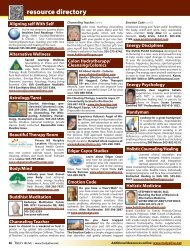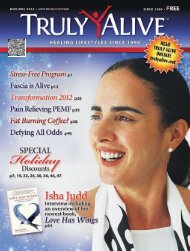reading - Truly Alive Magazine
reading - Truly Alive Magazine
reading - Truly Alive Magazine
You also want an ePaper? Increase the reach of your titles
YUMPU automatically turns print PDFs into web optimized ePapers that Google loves.
(converted by the organisms in our mouths and intestinal<br />
tracts). Mercury deforms developing brain architecture<br />
by altering the maturing and the migrating nerve cells, as<br />
well as interferes with the<br />
brain’s communication<br />
pathways, causing<br />
neurologic dysfunction,<br />
as well as nerve cell<br />
inflammation and<br />
eventual death, in both<br />
developing and mature<br />
nervous systems. Both<br />
forms of mercury<br />
continue accumulating<br />
throughout our lifetimes, prematurely aging our brains.<br />
Unfortunately, it is trending to create much earlier<br />
neurologic disease states in the younger generations,<br />
who are more genetically fragile to the neurotoxic effects<br />
both in the womb and postnatally to toxic stressors<br />
such as mercury. Such insults, combined with other<br />
neuroimmune stressors, e.g., food intolerances to a toxic,<br />
genetically altered, food supply, immunizations, clinically<br />
evasive low-grade infections, as well as electric pollution,<br />
all act as toxic burdens to the brain.<br />
Common sources of mercury exposure are:<br />
Coal burning power plants, Dental silver amalgams,<br />
Thermometers, Vaccinations, Contaminated fish,<br />
Exterior house paints, Germicidal agents and<br />
disinfectants, Insecticidal products, Seed preservatives,<br />
Wood preservatives, Chemical laboratories, Cosmetics.<br />
Note: Newer compact, energy-efficient fluorescent<br />
lights contain substantial mercury concentrations,<br />
making breakages with subsequent release a concerning<br />
source of exposure.<br />
Mercury and dental health:<br />
If you are like most Americans, you probably have<br />
mercury and/or other metal fillings in your mouth.<br />
Mercury fillings, also known as “silver fillings” or<br />
“amalgams,” are the most common fillings in the world.<br />
Called silver because of their color, they actually contain<br />
45 to 52 % mercury and only 30% silver. Copper, tin,<br />
silver and zinc make up the remaining volume. Scientific<br />
research has demonstrated that mercury, even in small<br />
amounts, can damage the brain, heart, lungs, liver,<br />
kidneys, thyroid gland, pituitary gland, adrenal gland,<br />
cells, enzymes and hormones, and suppress the body’s<br />
immune system. Mercury is continually released from<br />
dental fillings in the form of mercury vapor and abraded<br />
particles. Mercury vapors can increase as much as 15-fold<br />
by chewing, brushing, drinking hot liquids, etc. The World<br />
Health Organization recently concluded that the daily<br />
intake of mercury from amalgam dental fillings exceeded<br />
the combined daily intake of mercury derived from air,<br />
water and food (including fish). In human autopsy studies,<br />
it has been found that there is a direct correlation between<br />
the amount of mercury found in the brain and the number<br />
and surfaces of mercury fillings in teeth.<br />
A call to action: What are your treatment options?<br />
Begin by identifying your past and any ongoing mercury<br />
exposures, as well as your bodies’ current toxic burden. Then<br />
become informed on appropriate avoidance behaviors, as<br />
well as safe routes of mercury<br />
removal from your body and<br />
completely avoiding mercury<br />
amalgam fillings in the future.<br />
There are alternative techniques<br />
to treat metal toxicity<br />
problems. For those mercury<br />
amalgams already placed,<br />
consider the safe removal<br />
with a biological dentist or<br />
specialist, followed by chelation<br />
therapy. If your mouth<br />
is already mercury-free, and<br />
you’ve established your toxic<br />
burden, chelation therapy options can be pursued.<br />
If you wish to be evaluated for a neurotoxic assessment, please<br />
contact our office at 505-503-8325 for an appointment.<br />
Read more articles online: by Pamela www.trulyalive.net<br />
Costello online: www.trulyalive.net<br />
<strong>Truly</strong> <strong>Alive</strong> | May/June 2013 15














